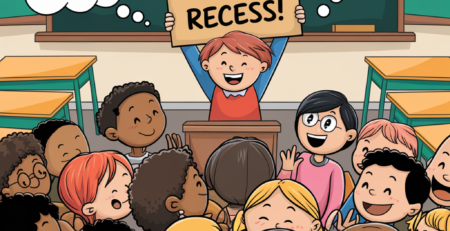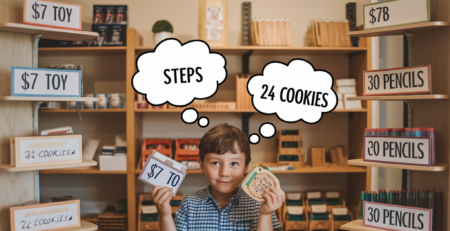Lesson Plan > Lesson 31 > Mathematics
Today is Review Time!
Review helps us strengthen our math muscles just like exercise strengthens our body muscles. When we practice skills we’ve already learned, we’re making sure they stay sharp and ready to use.
For elementary and middle levels, today is review time to reinforce what we’ve learned. For high-level learners, we’re diving into something new since we focused on review last time!
Elementary Level (Kinder to Grade 2)
Subject: Review and Games
Alignment with Standards:
- CCSS.MATH.CONTENT.1.OA.C.5: Relate counting to addition and subtraction
- CCSS.MATH.CONTENT.1.OA.C.6: Add and subtract within 20
- CCSS.MATH.CONTENT.1.OA.D.8: Determine the unknown whole number in an addition or subtraction equation
- CCSS.MATH.CONTENT.1.NBT.B.3: Compare two two-digit numbers
- CCSS.MATH.CONTENT.1.MD.C.4: Organize, represent, and interpret data
Objectives
By the end of this lesson, students will be able to:
- Demonstrate addition and subtraction skills within 20
- Identify and extend simple patterns
- Apply math skills in game-based contexts
- Collaborate with others during math activities
- Self-assess their understanding of key concepts
Materials
- Number cards (1-20)
- Dice (regular and dot dice)
- Counters or manipulatives (blocks, buttons, etc.)
- Pattern cards or blocks
- Addition and subtraction flashcards
- Math bingo cards
- Timer
- Small prizes or stickers (optional)
- Whiteboard and markers
Lesson Structure (90 minutes)
Introduction (10 minutes)
- Math Circle Time (5 minutes)
- Gather student in a circle
- Quick review of addition/subtraction concepts covered so far
- Introduce the games focus for today’s lesson
- Warm-Up Activity (5 minutes)
- “Count and Move”: Count forward to 20 while doing jumping jacks
- Count backward from 20 while marching in place
- Count by 2s to 20 while clapping hands
Rotation of Games (60 minutes)
Set up 4 game stations. Student will spend 15 minutes at each station.
Station 1: “Addition War” (15 minutes)
- Materials: Deck of number cards (remove face cards)
- Instructions:
- Two players each flip over two cards
- Each player adds their two cards
- The player with the higher sum wins all cards from that round
- Continue until all cards are used
- The player with the most cards at the end wins
Station 2: “Subtraction Roll” (15 minutes)
- Materials: Two dice, paper, pencil
- Instructions:
- Roll two dice
- Subtract the smaller number from the larger number
- Record the equation and difference
- Award a point for correct answers
- First player to 10 points wins
Station 3: “Pattern Play” (15 minutes)
- Materials: Pattern blocks, pattern cards
- Instructions:
- Create simple patterns using blocks (AB, AAB, ABC patterns)
- Have student identify and continue the pattern
- Challenge student to create their own patterns for you to solve
- Match pattern cards with corresponding block patterns
Station 4: “Math Bingo” (15 minutes)
- Materials: Bingo cards with numbers 1-20, equation cards
- Instructions:
- Create bingo cards with numbers 1-20
- Call out addition or subtraction problems (e.g., “3+4”)
- Student finds the answer (7) on their bingo card and covers it
- First to get five in a row calls “Bingo!”
Whole Group Review Game (15 minutes)
“Around the World” Math Facts
- Students stand in a circle
- Teacher states a math fact (addition or subtraction within 20)
- Students raise hand when they know the answer
- First student to answer correctly moves to the next position
- Continue until everyone has had multiple chances to answer
Conclusion and Assessment (5 minutes)
- Thumbs Up/Down Check: Ask quick review questions and have student show understanding with thumbs up/down
- Exit Ticket: Student completes 3 simple addition/subtraction problems on a small paper
- Reflection: Ask student what game they enjoyed most and why
Differentiation
- For students needing support: Use smaller numbers (within 10), provide number lines or counters
- For students needing challenge: Use higher numbers, introduce missing addend problems, create more complex patterns
Extension Activities
- Have student create their own math game to play next lesson
- Send home pattern cards for additional practice
- Challenge student to find patterns in everyday objects at home
Assessment
- Observe student engagement and accuracy during games
- Review exit ticket for understanding
- Note any concepts needing reinforcement for future lessons
Home Connection
- Share games played in class that can be easily replicated at home
- Suggest everyday activities that reinforce addition/subtraction (counting items while shopping, etc.)
- Provide a simple pattern scavenger hunt activity for home
Mid Level (Grade 3 to 5)
Subject: Review and Games
Alignment with Standards:
- CCSS.MATH.CONTENT.4.OA.A.3: Solve multistep word problems using the four operations
- CCSS.MATH.CONTENT.4.NBT.B.4: Fluently add and subtract multi-digit whole numbers using the standard algorithm
- CCSS.MATH.CONTENT.4.NBT.B.5: Multiply a whole number of up to four digits by a one-digit whole number
- CCSS.MATH.CONTENT.4.NF.A.1: Explain why fractions are equivalent and use visual fraction models
- CCSS.MATH.CONTENT.4.NF.B.3: Understand addition and subtraction of fractions as joining and separating parts of the same whole
Objectives
By the end of this lesson, students will be able to:
- Apply the four operations to solve multistep word problems
- Demonstrate fluency with multi-digit addition and subtraction
- Show understanding of multiplication strategies
- Identify equivalent fractions and perform basic fraction operations
- Engage in collaborative problem-solving using math vocabulary
Materials
- Math bingo cards covering various 4th grade concepts
- Device with internet access for Kahoot quizzes
- Whiteboards and markers
- Index cards for creating math problems
- Dice (regular and fraction dice if available)
- Timer
- Fraction manipulatives or visual models
- Place value charts
- Small prizes or stickers (optional)
- Printed problem-solving scenarios
Lesson Structure (120 minutes)
Warm-Up (15 minutes)
- Math Fact Challenge (10 minutes)
- Quick mixed review of multiplication facts (0-12)
- Division fact practice with whiteboard responses
- Mental math addition and subtraction with 2-3 digit numbers
- Review Goals Discussion (5 minutes)
- Briefly discuss which math topics students feel confident about
- Identify areas they’d like more practice with
- Set personal goals for the review session
Math Bingo (30 minutes)
- Materials: Custom math bingo cards with answers to various problems
- Setup: Create bingo cards with numbers that are answers to various math problems
- Instructions:
- Distribute different bingo cards to each participant
- Call out math problems instead of numbers (e.g., “8 × 7” or “356 + 127”)
- Students solve the problem and mark the answer on their card if they have it
- First to get 5 in a row calls “Bingo!” and verifies answers
- Play multiple rounds focusing on different operations
- Variations:
- Fraction bingo with equivalent fractions
- Word problem bingo focusing on multistep problems
- Place value bingo with expanded form and standard form
Kahoot Quiz Session (30 minutes)
- Materials: Device with internet access, pre-made Kahoot quizzes
- Instructions:
- Load pre-created Kahoot quizzes on 4th grade math topics
- Play 2-3 different quizzes focusing on:
- Multi-digit operations
- Fractions and decimals
- Word problems
- Measurement and data
- After each quiz, review any questions that were challenging
- Have students explain their thinking process for correct answers
Interactive Problem-Solving Station Rotation (35 minutes)
Set up 3 problem-solving stations. Students will spend approximately 10-12 minutes at each station.
Station 1: “Math Mystery Bags” (12 minutes)
- Materials: Paper bags with clues and a final problem
- Instructions:
- Each bag contains a multi-step problem broken into clues
- Students work through clues in sequence to solve the mystery
- Problems integrate multiple math concepts (operations, fractions, etc.)
- Record solutions and reasoning on provided worksheet
Station 2: “Fraction Action” (12 minutes)
- Materials: Fraction dice, fraction manipulatives, challenge cards
- Instructions:
- Roll fraction dice to create fractions
- Compare, add, subtract, or find equivalent fractions based on challenge card
- Use manipulatives to model and verify solutions
- Record all work on whiteboard
Station 3: “Word Problem Workshop” (12 minutes)
- Materials: Word problem cards of varying difficulty
- Instructions:
- Select a word problem card
- Identify the key information and operations needed
- Solve using a step-by-step approach
- Create a similar word problem for others to solve
Wrap-Up and Assessment (10 minutes)
- 3-2-1 Reflection: Have students write:
- 3 things they feel confident about
- 2 areas they want to practice more
- 1 question they still have
- Exit Ticket: Solve one final challenge problem that incorporates multiple concepts
- Preview: Briefly introduce the next math unit/topic to build anticipation
Differentiation
- For students needing support: Provide simpler problems, allow use of calculators for complex calculations, offer visual aids
- For students needing challenge: Include higher-level problems, have them create their own math challenges, add time constraints
Extension Activities
- Create a math game to teach a specific concept to someone else
- Math scavenger hunt that applies concepts to real-world scenarios
- Online adaptive practice through recommended math websites
Assessment
- Observe accuracy and speed during games
- Note specific areas of strength and weakness for targeted future instruction
- Review exit tickets and reflection responses
- Track progress on key standards through Kahoot results
Home Connection
- Share links to online Kahoot quizzes for additional practice
- Suggest family-friendly math games that reinforce review concepts
- Provide a “Math Challenge of the Week” related to current review topics
High Level (Grade 6 to 8)
Subject: Order of Operations (Including Rational Numbers)
Alignment with Standards:
- CCSS.MATH.CONTENT.7.NS.A.1: Apply and extend previous understandings of addition and subtraction to add and subtract rational numbers
- CCSS.MATH.CONTENT.7.NS.A.2: Apply and extend previous understandings of multiplication and division to multiply and divide rational numbers
- CCSS.MATH.CONTENT.7.NS.A.3: Solve real-world and mathematical problems involving the four operations with rational numbers
- CCSS.MATH.CONTENT.7.EE.A.1: Apply properties of operations as strategies to add, subtract, factor, and expand linear expressions
- CCSS.MATH.CONTENT.7.EE.B.3: Solve multi-step real-life and mathematical problems posed with positive and negative rational numbers
Objectives
By the end of this lesson, students will be able to:
- Explain and apply the order of operations (PEMDAS/BEDMAS) rule
- Evaluate expressions containing multiple operations and grouping symbols
- Solve expressions involving fractions and decimals
- Convert between fraction and decimal forms to facilitate calculations
- Apply order of operations in real-world scenarios
- Create their own expressions to demonstrate understanding of operation hierarchy
Materials
- Student workbook or notebook
- Calculator (for checking work only)
- Whiteboard and markers
- Order of operations reference cards
- Practice worksheets with tiered difficulty levels
- Fraction manipulatives or fraction strips
- Deck of number and operation cards for game activities
- Digital presentation with examples
- “Order of Operations” anchor chart
- Exit ticket template
Lesson Structure (90 minutes)
Introduction (15 minutes)
- Warm-Up Problem (5 minutes)
- Write on board: 4 + 3 × 2
- Ask: “What is the answer? 14 or 10?”
- Have student explain their reasoning
- Use this to highlight the importance of operation order
- Concept Introduction (10 minutes)
- Introduce the mnemonic PEMDAS (Parentheses, Exponents, Multiplication/Division, Addition/Subtraction)
- Emphasize that multiplication/division are performed left to right, as are addition/subtraction
- Show common errors when order is not followed correctly
- Explain why we need a standardized order (to ensure consistent answers)
Direct Instruction (20 minutes)
- Basic Order of Operations (5 minutes)
- Work through simple examples with whole numbers:
- 3 + 5 × 2
- 24 ÷ 6 + 3 × 2
- 7 × (4 – 2) + 5
- Work through simple examples with whole numbers:
- Introducing Rational Numbers (15 minutes)
- Define rational numbers (fractions, decimals, integers)
- Model expressions with fractions:
- 2/3 + 1/4 × 2
- 5 – 3/4 ÷ 1/2
- Model expressions with decimals:
- 4.5 + 2.3 × 1.2
- (3.6 ÷ 0.9) – 1.5
- Demonstrate converting between forms when helpful
Guided Practice (20 minutes)
- Worked Examples (10 minutes)
- Solve together step-by-step:
- 3/4 × (2.5 + 1.5) – 1/3
- 5 – [2 + (3 – 3/4)] × 0.5
- 2^2 + 3/8 ÷ (1/4) – 0.6
- For each example:
- Identify the steps in order
- Show all work clearly
- Convert fractions/decimals as needed
- Solve together step-by-step:
- Error Analysis (10 minutes)
- Present incorrect solutions
- Have student identify the errors
- Ask student to correct the work and explain the proper approach
Independent Practice (20 minutes)
- Tiered Practice (15 minutes)
- Level 1: Basic expressions with parentheses and rational numbers
- Level 2: Expressions with nested parentheses
- Level 3: Multi-step expressions with mixed operations and rational numbers
- Student completes problems at their comfort level, showing all steps
- Real-World Application (5 minutes)
- Present a word problem requiring order of operations:
- “A recipe calls for 2/3 cup flour for each batch. You’re making 1.5 batches plus an extra 1/4 cup for dusting. How much flour do you need?”
- Guide student in translating this to an expression: (2/3 × 1.5) + 1/4
- Present a word problem requiring order of operations:
Interactive Application (10 minutes)
“Build an Expression” Activity
- Use cards with numbers (including fractions and decimals) and operation symbols
- Student draws cards to create expressions that equal a target number
- Must use at least one fraction or decimal and one set of parentheses
- Explain why the expression equals the target value using order of operations
Assessment and Closure (5 minutes)
- Exit Ticket: Solve 2-3 expressions applying order of operations with rational numbers
- Reflection Question: “Why is the order of operations important when working with rational numbers? How does it help us solve problems consistently?”
- Preview: Mention how order of operations will be important in upcoming algebra work
Differentiation
- Support: Provide a step-by-step checklist, allow use of calculator for arithmetic after order is determined, use simpler fractions
- Extension: Create expressions with multiple sets of nested parentheses, incorporate negative rational numbers, design order of operations puzzles
Extension Activities
- Create an order of operations game for a younger student
- Find and correct errors in “supposedly correct” math solutions online
- Apply order of operations to evaluate formulas with given values
Assessment
- Observe student’s process during guided and independent work
- Review exit ticket for accuracy and process
- Check student’s ability to identify errors in the error analysis activity
Home Connection
- Find examples of order of operations in cooking recipes or financial calculations
- Create a “math mistake of the day” for family members to correct
- Practice with online order of operations games













LEAVE A COMMENT